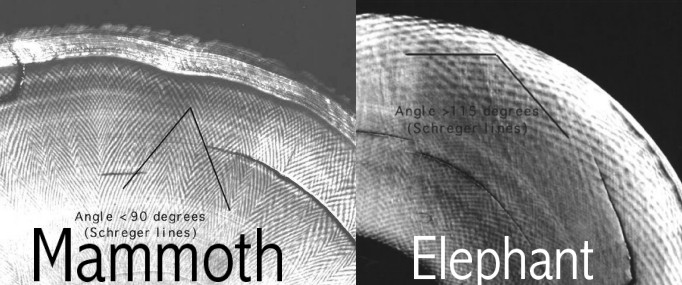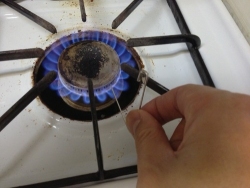

Real Ivory vs. Bone or Resin ( Synthetic Products)


The first test one should use when attempting to differentiate between ivory, and bone or resin is to use a magnifying glass or jewelers loop to see what the surface looks like.
- Bone will have minute pores, which most often appear black or brown after accumulating dirt and contaminents, and will not have lines running through the piece.
- Resin will be perfectly uniform.
- Ivory will have " Schreger lines", most apprarent in elephant ivory. These lines may be cross-hatched as with elephant ivory, or may just appear as circular rings.

After little experience it is easy to tell the difference between resin and ivory. Resin has the weight of ivory, but is too uniform, and lacks a patina. Some fake ivory actually contains bone or powdered ivory, and may have lines, yet they are too uniform and will always fail the hot pin test.

The hot pin test can be used to detect synthetic ivory. One simply heats a pin to red hot, and if the pin sinks into the item-it is not ivory. A hot pin will not penetrate real ivory even a little, one may catch that familiar dentists drill smell of burning teeth, but this will be faint. Resin will smell like burning plastic. This is not recommended for very valuable items that do not present an indiscreet place in which to place the hot pin. Bone will often smoke if exposed to excessive heat.
A quicker test is to place the item on one's cheek, if the item is cold then it maybe real, a very similar test is used to tell glass buttons from plastic. This test has many variables, the temperature of the item and of the room and so forth. Resin will adjust to heat much quicker then ivory. Xylonite can appear as ivory at a distance, but it is much too light. Xylonite was used to mimic ivory items such as brushes, combs and trinket boxes, and is collectable in it's own right, but it is not nearly as valuable as a similar ivory item.
Ivory which is considerably harder will take considerable force to produce even a scratch, as any scrimshaw artist can attest. Mammoth ivory which is being utilised in such places as Alaska varies as far as color from beige to a dark coffee colour depending on the minerals in which it has been exposed. Most of these items are recent productions and as yet have not been reproduced in resin.
It maybe impossible to see " Schreger lines" in mammoth ivory, but the hot pin test or the weight will indicate whether it is real. Antique ivory is very easy to fake! Such methods as soaking a newly carved item in tea or burying it under a tree ( a tree with leaves containing a lot of tannic acid) can simulate an antique appearance. Buyer beware! One cannot tell if an ivory item is real or not by a picture!
As with any item one should ask the seller a question, not only as regards the origin of the item but in order to ascertain how responsive the seller is. Make sure the seller will offer a refund for items misdescribed or repaired. Ivory is easy to repair by glueing, at least easy enough that most buyers may miss the repair at first.